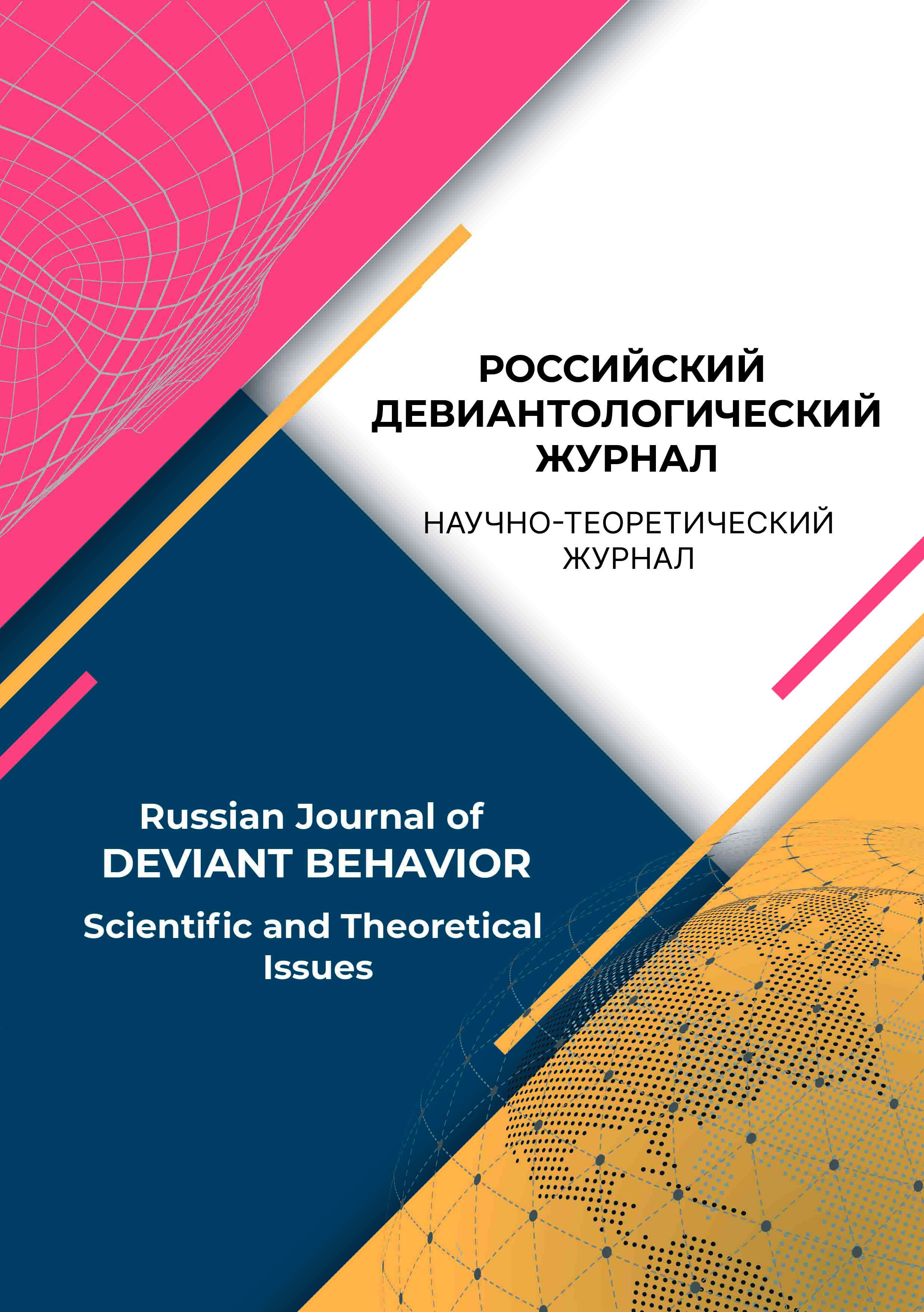from 01.01.2016 until now
Russian Federation
from 01.01.2016 until now
Russian Federation
from 01.01.2020 until now
UDC 15
Introduction. The necessity to counteract vandalism is due to economic, cultural and social losses. Inefficiency of the actual preventive programs calls for a new research of vandalistic behavior motives and ways to control them. The paper deals with subjective effects of vandalism – youths’ perception of vandalistic damage to urban area. Youths’ attitude to vandalistic behavior is supposed to get shaped already at the perception stage, that is why research of this stage is viewed as essential to reveal initial and regulatory drivers of vandalism. Objectives. The study is aimed at researching special aspects of youths’ perception of vandalism through identification of cognitive, emotional, valueand-sense, attitude and visual motor components of a perceptual act. The goal of the study implies the following research challenges: 1. to identify subjectively essential forms of vandalism; 2. to reveal conventional forms of vandalism; 3. to discover the effect of role-oriented position on vandalism perception; 4. to identify the effect of vandalistic experience on visual motor characteristics of vandalistic stimuli perception. Methods. Phenomenological approach to social-environmental research of urban area is the major tool of the study. This method enables to explain some research findings by subjective attitude of urban youths to vandalistic damages. In the course of the experiment this attitude manifested itself in the evaluation and orientation as reaction to images of urban vandalistic damages. The main research procedure is experiment. In the course of the experiment a subject was given stimuli, his visual motor reactions and changes of their ophthalmic system were fixed. Data were collected through self-evaluation reports fixing psychoemotional state, attitude and understanding of vandalistic damages, as well as through an eye tracker Tobii Pro Spectrum measuring oculomotor responses to the stimuli. The processing method was descriptive statistics, U-criteria of Mann-Whitney. Participants and stimuli. The stimuli were 10 images of vandalistic damages to urban area. The survey sample included 103 people aged 19-24 with proportional correlation of men and women. They were divided into 8 focus groups. The experiment lasted 1 hour and 40 minutes for each group. The eye tracker research was conducted with a group of 11 people (72,2 % – girls). Results: 1) Subjectively significant forms of vandalism are graffiti, littering and property destruction. 2) Conventional forms of vandalism are damage to recreational areas, the building and its premises. 3) Roles I-vandal and I-viewer (observer) differ in evaluation of admissibility of vandalistic actions and their significance. 4) Previous vandalistic experience affects visual motor characteristics of vandalistic damages perception. Scientific novelty. The research findings give a wider scope of vandalistic actions perception, proving that a role-oriented position influences on evaluation of vandalistic damages and vandalistic experience, predetermines orientation and evaluation of vandalistic damages. Practical significance. Developed research procedure of vandalistic damages to urban area perception enables to collect data about oculomotor response and can be applied for similar research.
vandalism, vandalism perception, evaluation of vandalistic actions, urban area, eye tracking
1. Ceccato, V., Haining, R. (2004). Crime in Border Regions: The Scandinavian Case of Öresund, 1998-2001. Annals of the Association of American Geographers 94(4), 807-826.
2. Clark, R. (2008). How to control litter in recreation areas. Annual Review of Psychology, 77, 112-122.
3. Cohen, S. (1973). Destruction of property: Motives and meanings. Vandalism, 23-53.
4. DeShay, R. A., Vasquez, A. G., Vieraitis, L. M. (2020). You Gotta Have a Plan so You Won’t Get Caught. Managing the Risks of Street Tagging. Deviant Behavior, 1-18. doihttps://doi.org/10.1080/01639625.2020.1722339.
5. Francuz, P., Zaniewski, I., Augustynowicz, P., Kopiś, N., Jankowski, T. (2018). Eye Movement Correlates of Expertise in Visual Arts. Frontiers in human neuroscience, 12, 87.
6. Fraser, A., Matthews, D. (2019). Towards a criminology of atmospheres: Law, affect and the codes of the street. Criminology & Criminal Justice. 174889581987485. doihttps://doi.org/10.1177/1748895819874853.
7. Häfele, J. (2013). Die Stadt, das Fremde und die Furcht von Kriminalität. Wiesbaden: Springer VS.
8. Halsey, M., Young, A. (2006). Our desires are ungovernable. Theoretical Criminology 10(3), 275-306. doihttps://doi.org/10.1177/1362480606065908.
9. Hinkle, J. C., Yang, S. (2014). A new look into broken windows: What shapes individuals’ perceptions of social disorder. Journal of Criminal Justice, 42, 26-35.
10. Hinterlehner, H., Hummelsheim-Doss, D., Sessar, K. (b.d.). Kriminalitätsfurcht. Über die Angst der Bürger vor dem Verbrechen . Baden-Baden: Nomos.
11. Hirtenlehner, H., Leitgöb, H., Stiebellehner, K., Birklbauer, A., Bacher, J. (2019). Vandalismus und Sachbeschädigungsdelinquenz von Kindern und Jugendlichen. Zeitschrift fuer Jugendkriminalrecht und Jugendhilfe, 2, 120-132.
12. Kindynis, T. (2017). Bomb Alert: Graffiti Writing and Urban Space in London. The British Journal of Criminology 58 (3), 511-528. doihttps://doi.org/10.1093/bjc/azx040.
13. Melcher, D., Bacci, F. (2013). Perception of emotion in abstract artworks: a multidisciplinary approach. Progress in Brain Research, 20, 191-216.
14. Mushtaha, E. (2016). The Effect on Vandalism of Perception Factors Related to Housing Design, Case of U. A. E Cities. Journal of Asian Architecture and Building Engi-neering 15 (2), 247-254.
15. Oberwittler, D., Janssen, H., Gerstner, D. (2017). Unordnung und Unsicherheit in großstädtischen Wohngebieten - Die Überschätze Rolle von „Broken Windows“ und die Herausforderungen ethnischer Diversität. Soziale Probleme, 28, 18.
16. Pavlova, N. V., Pavlov, Y. G., Zlokazov, K. V. (2018). Visual perception of urban vandalism. International Journal of Psychophysiology, 131, 121. doihttps://doi.org/10.1016/j.ijpsycho.2018.07.328.
17. Quiroga, R. Q., Pedreira, C. (2011). How do we see art: an eye-tracker study . Frontiers in human neuroscience (5), 98.
18. Schneider, M. (2002). Vandalismus. Erscheinungsformen, Ursachen und Prävention zerstörerischen Verhaltens sowie Auswirkungen des Vandalismus auf die Entstehung krimineller Milieus. Aachen: Schneider.
19. Simpson, A., Thomas, N. A. (2018). Neuroticism, schizotypy, and scale anchors influence eye movement behaviour in the visual exploration of abstract art: An exploratory study. Acta Psychologia, 18(3), 85-98.
20. Vorobyeva, I. V., Kruzhkova, O. V., Krivoshchekova, M. S. (2015). The genesis of vandalism: From childhood to adolescence. Psychology in Russia: State of the Art, 8 (1), 139-156.
21. Westover, T. N. (1985). Perceptions of crime and safety in three midwestern parks. The Professional Geographer, 37(4), 410-420.
22. Wilson ,J., Kelling, G. (1982). The Police and Neighborhood Safety: Broken Windows. The Atlantic Monthly, P. 29-38.
23. Abramova, Yu. (1995). Psikhologiya sredy: istochniki i napravleniya razvitiya. Voprosy psikhologii, 2, 130-137.
24. Barabanshchikov, V. A., Zhegallo, A. V. (2013). Registratsiya i analiz napravlennosti vzora cheloveka. Moskow: Izd-vo «Institut psikhologii RAN».
25. Barabanshchikov, V. A., Zhegallo, A. V. (2014). Aytreking: Metody registratsii dvizheniy glaz v psikhologicheskikh issledovaniyakh i praktike: uchebnoye posobiye. Moskow: Kogito-tsentr.
26. Volkova, Ye. N., Mititsina, Ye. A. (2020). Obzor psikhologicheskikh issledovaniy vandalizma detey i podrostkov kak osnova proyektirovaniya programm profilaktiki v obrazovatel’noy sred. Vestnik Mininskogo universiteta, 3(32), 6.
27. Vorob’yeva, I. (2019). Vandalizm v gorodskoy srede kak marker nebezopasnosti territorii. Vestnik Omskogo universiteta. Seriya: Psikhologiya, 4, 5-10.
28. Vorob’yeva, I. V. (2018). Vandalizm v gorodskoy srede: deviatsiya ili kommunikatsiya. Yekaterinburg: Ural. gos. ped. un-t.
29. Vorob’yeva, I. V., Kruzhkova, O. V. (2012). Psikhologiya gorodskoy sredy. Yekaterinburg: RGPPU.
30. Krasnov, V. S., Korobkin, N. E. (2017). Psikhologiya zdorov’ya i bolezni: kliniko-psikhologicheskiy podkhod. Materialy VII Vserossiyskoy konferentsii s mezhdunarodnym uchastiyem. Sravnitel’nyy analiz tekhnicheskikh i funktsional’nykh kharakteristik aytrekerov. Kursk, Rossiya.
31. Merlo-Ponti, M. (1999). Fenomenologiya vospriyatiya. Saint Petersburg: Yuventa.
32. Pavlov, V. (2017). Voprosy otvetstvennosti za vandalizm v zarubezhnom ugolovnom zakonodatel’stve. Vestnik Sankt-Peterburgskoy yuridicheskoy akademii 4 (37), 85-90.
33. Fazylzyanova, G. I., Balalov, V. V. (2014). Aytreking: kognitivnyye tekhnologii v vizual’noy kul’ture. Vestnik Tambovskogo universiteta. Seriya: Yestestvennyye i tekhnicheskiye nauki, 16(2), 628-633.














